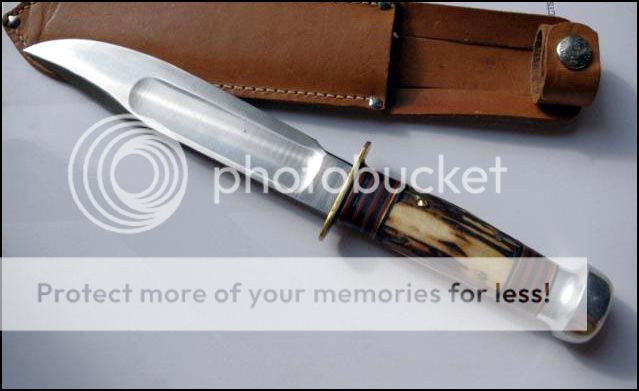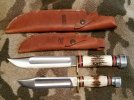Prior to the late 19th century, outdoorsmen and military personnel did not use knives that were notably different from the knives used by butchers. Blades were relatively thin and the handles were often no more than two wooden slabs riveted to the tang. Serrations appeared on knives in the 19th century for use as a wood saw or fish scaler. Around the turn of the century, Webster L. Marble introduced the modern concept of the "hunting knife." These knives incorporated heavier blades, crossguards, and pommels. They very much resembled miniaturized Bowie knives.
Marble Safety Axe Company, Gladstone Manufacturing Company,
rifles, gun sights, axes, hunting knives, and other outdoor accessories\
Founder - Webster L. Marble
Gladstone, Michigan, United States
Birth: Mar. 23, 1854
Milwaukee
Milwaukee County
Wisconsin, USA
Death: Sep. 22, 1930
Delta County
Michigan, USA
son of Lansing Marble and a grandson of Jason Marble, the latter from Vermont and of English descent.
Marble loved the outdoors and the vast Upper Peninsula offered innumerable opportunities to hunt, fish, camp and explore the environment. An inventor by nature, he was continually seeking to create useful tools and equipment that would be both practical and durable in the outdoors.
Marble Arms created the Ideal hunting knife in 1898.
Webster L. Marble was the third born of six children, and his life's history is a story of wonderful success. Born in Milwaukee. Wisconsin, while yet a small boy his parents moved to Vassar, Michigan, and there his youth was spent. His father was a woodsman, hunter and trapper, and the son became a "chip of the old block," for nothing pleased him better than a tramp in the woods for game or fish, and he soon became an expert trapper, hunter and fisherman. His natural love of the woods and all field sports led him to take up the occupation of surveyor and timber cruiser, and he followed that work for twenty five years, first around his home at Frankfort, Michigan, where his parents had moved when he was fifteen years of age. and later in the Upper Peninsula of Michigan, with headquarters at Gladstone.
During these years in the woods he came more and more to feel the need of an axe light enough to be carried in his pocket while cruising, yet of practical utility. Moreover he realized the necessity of a waterproof match box, and setting himself to the task of supplying these articles the Safety Pocket Axe and the Water-proof Match Box were the result. Circumstances and a natural inventive mind have combined to lead up to the twenty or more patents which were secured and which are now the foundation of this large enterprise. Mr. Marble built a little shop back of his home where he set up a small engine and some light machinery. At odd hours, between his trips in the woods, he thought and planned, developing his patents and working out his ideas, for he did not give up his regular employment. Thus he continued on for several years, and in August of 1898 enlarged his shop to six hundred and forty square feet of floor space and began the manufacture of one style of safety axe. In the next year Mr. F. H. Van Cleve of Escanaba, Michigan, became a partner in the business and a new factory covering nine thousand square feet was built. It has since been enlarged to thirteen thousand square feet. The amount of the business of the Marble Safety Axe Company has nearly doubled each year since its organization, and the word "Marble" has become a synonym for extra quality in sporting equipment.
Kenosha Evening News Wed Sept 24, 1913.
His favorite tie pin was a miniature Safety Ax, not only bacause he was proud of his invention, but because an ax symbolized a woodsman.
Webster L. Marble - shown in photo below at age 55.

In 1890 Webster L. Marble also became connected with the banking business, being made in that year the president of the Exchange Bank at Gladstone, one of the strongest banking houses of this section of the state. He has ever since filled that important position. He married in 1878 Rosa M. Derry, a resident at that time of Frankfort, Michigan, but born in Fulton, New York, a daughter of William T. and Harriet Derry. Two sons have been born to Mr. and Mrs. Marble, William L. and Floyd W., the elder the manager of the Marble Safety Axe Company, and the younger assistant cashier in the Exchange Bank. Mr. Marble is a member of the Republican party, of the Gladstone school board and of the Masonic order. He is also a member of the Methodist Episcopal church, and is one of the trustees and the present treasurer of his church. The place he was won in business circles is accorded him in recognition of his skill and ability and as a tribute to true and genuine worth.
Frank H. Van Cleve of Escanaba, Michigan shared patent rights on some of the early patents applied for by Webster L. Marble
Marble's Woodcraft is one of the most instantly recognized knives that was ever made in the entire world. Patent applied for in 1915, W L Marble was quoted: Be it be known that I, Webster L Marble...have invented a new & original Design for a Blade of a new Hunting Knife...that patent was granted to Marble on February 22, 1916...the Woodcrafts success not only in the USA but also around the world became legendary! After the patent ran out in 1930, the Woodcraft became the most copied knife blade pattern by almost every other knife company in the world. (see photo below)
Marble's Ideal was the 1st knife in the Marble's lineup.
Some famous people to carry Marble's Ideal knives were Teddy Roosevelt, Peary & Byrd who were the explorers to reach the north & south poles. Charles Lindbergh carried a Marble's Ideal, in the cockpit of the 1st solo Trans-Atlantic flight, now it's on display in the Smithsonian Institution.
Another knife made was the Marbles Sport. This knife pattern came out about 1930,, Marble's made one version of this identical knife with a collaboration with the late Bob LoveLess, it had a drop point blade pattern. In the 1930's, this knife was the Official knife of the Boy Scouts & Girl Scouts of America.
The Marble's Expert knife is the Marbles Corp. longest running pattern than any other of Marbles original designs. This knife started in the Marble's line in 1906. W.L. Marble's intent was to offer a a knife suited to the professional hunter, guides, trapper, that needed a light blade for skinning & dressing, yet with enough strength to handle all the rest of regular outdoor chores.
The Marble's Trailmaker knife is the biggest knife Marble's ever made at 15" OAL. It was the heaviest at over 1 LB, and it was the most expensive knife ever offered in Marble's Corp.
And Marble Knives made the stacked leather handles famous......
[/URL]
Timeline
1887 Webster Marble moves family to Gladstone, Michigan.
1890 Marble founds Gladstone Exchange Bank and is President.
1892 Manufactures Universal Rifle Sight and incorporates as Gladstone Manufacturing Company.
1893 Makes first Pocket Axes; recession causes Panic of 1893.
1894 Marble returns to surveying and timber cruising.
1898 Patents Safety Pocket Axe and incorporates as Marble Safety Axe Company.
1899 Exhibits first products at Sports Expo in Madison Square Garden.
1902 Introduces Improved Front Sight; British Army adopts Marbles No. 3 Safety Pocket Axes.
1903 Patents Automatic Flexible Joint Rear Sight.
1909 New 24,000 square foot factory completed and lauded as “Finest of its kind in the world.”
1910 First Game Getter Guns shipped from the factory.
1912 Magazine advertising reaches 20,000,000 readers world wide.
1913 Theodore Roosevelt carries Marble’s compasses during Expandicao Scientifica exploration of Brazilian wilderness.
1914 WWI U.S. Army trucks equipped with Marble’s compasses.
1916 British government buys Marble’s hunting knives for Army issue.
1927 Charles Lindbergh carries Marble’s knife, compass, and matchbox on first solo transatlantic flight.
1930 Founder, Webster Marble dies. Son William becomes President; son Floyd is President of subsidiary Marble Card.
1957 Marble Arms is purchased by Bell and Gossett Inc.
1958 Marble Arms Corporation sells 500 Pilot Survival knives to U.S. Navy and releases proprietary manufacturing specifications.
1966 New plant built at present location
Something I thought was pretty interesting putting this post together, was they said he was very sought after for his ability to look at an area of forest and tell you approximately how many board feet of lumber you get out of it?
And I guess he was right most of the time?
And out of the thousands of adds and magazine articles over the early years, with millions of viewers. The ONLY real person they ever used in an add in a catalog... was a guy named Captain Jack.
Captain Jack
Marble - DeWeese........ knife maker designer in photo below.
.
I did a thread on custom knife history - click on the link below to read all of it. -- cool thread.
http://www.bladeforums.com/forums/showthread.php/1118349-Custom-Knife-History
.



















